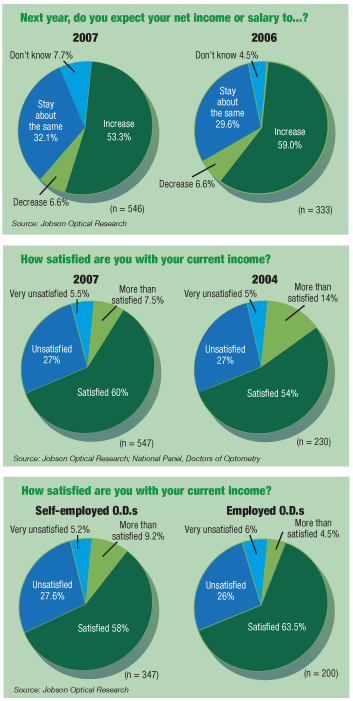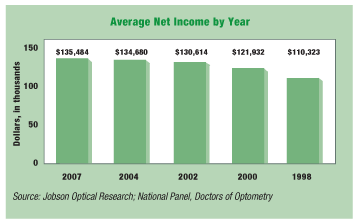
Its the economy, stupid! goes the old political slogan. The same can be said today: Many of your current troubles can be blamed on the lousy economy. Although the economy hasnt hurt optometrists as badly as other professions, it still has optometrists in a pinch: Net income is flat, and gross income may have dipped. But, profit margins have held steady. And, perhaps surprisingly, optometrists remain largely satisfied with their income.
Median Net Income Average Net Income by Years in Practice Average Gross Revenue All O.D.s
Highlights of Review of Optometrys
2007 Income Survey
Average Net Income
$135,484 (n = 539)
$120,000 (n = 539)
Less than 10 years
$111,080 (n = 198)
11 to 20 years
$138,337 (n = 142)
21 to 30 years
$159,614 (n = 134)
More than 30 years
$148,946 (n = 71)
Self-employed O.D.s Average Net Income
All self-employed O.D.s
$151,548 (n = 340)
Solo practitioner
$142,405 (n = 191)
Partner/group practitioner
$177,783 (n = 116)
$115,500 (n = 13)
Other
$110,131 (n = 20)
Employed O.D.s Average Net Income
All employed O.D.s
$107,899 (n = 198)
Other O.D. or M.D.
$107,367 (n = 92)
Corporation
$98,800 (n = 35)
HMO/PPO
$109,225 (n = 20)
Other
$114,584 (n = 51)
$469,711 (n = 498)
Median Gross Revenue All O.D.s
$400,000 (n = 498)
Self-Employed O.D.s Average Gross Revenue
$529,478 (n = 333)
Self-Employed O.D.s Median Gross Revenue
$482,000 (n = 333)
Employed O.D.s Median Gross Revenue
$200,000 (n = 165)
These are some of the results of Review of Optometrys 20th Income Survey.
Note that this article compares 2007 income against 2004 income. In last years income survey, which reported 2006 income, we solicited responses by e-mail and calculated estimated income based on respondents selection from a range of income levels. (No survey was performed for 2005 income.)
This year, we refined our electronic survey so that respondents could enter their exact income amount, which produced (hopefully) more exact numbers. So, thats why we compare these 2007 results against the most consistent recent results, which were from 2004.
Net Income is Flat
According to our results, the average optometrist (both self-employed and employed doctors) had an annual net income of $135,484 in 2007. Compare that to $134,680 in 2004. Thats an increase of less than 1%. (Bear in mind that we changed our survey methodology: For our 2004 survey, we sent 1,500 questionnaires by U.S. Mail, and 230 optometrists responded. For our 2007 survey, we e-mailed more than 22,000 optometrists, and 548 responded.)
Very extreme salaries, either very high or very low, can skew the average income. So, median incomethe midpoint amount of all responsesmay provide a better snapshot of the typical optometrists income. Among all O.D.s, median net income was $120,000 in 2007, compared with $117,000 in 2004an increase of 2.6%.
However, inflation rose nearly 10% during the same period (based on the U.S. Consumer Price Index, the standard measure of inflation). So, in real dollars, optometrists have lost net income in the past three years. Actually, theyve lost income since 2002, as median income was flat between our 2002 and 2004 surveys.

Self-Employed and Employed
Average income for self-employed doctors (those in private practice, partnerships, groups or franchises) increased from $140,540 in 2004 to $151,548 in 2007. Thats a rise of almost 8% in three years. (Among all modes of employment, doctors in partnerships or groups took home the most net income in 2007: $177,783.)
Median net income for self-employed O.D.s managed to keep pace with inflation, rising about 10%, from $120,060 in 2004 to $132,400 in 2007.
Average income for doctors who are employed (by another doctor, a corporate firm, an HMO or PPO, or in other employment) rose significantly, from $97,680 in 2004 to $107,899 in 2007, an increase of more than 10%.
Also, median net income for employed doctors rose higher, from $82,000 in 2004 to $100,000 in 2007, a gain of almost 22%.
While the sky is the limit for private-practice income (in theory, anyway), many employed O.D.s say theyre also doing just fine. I have 30 days of vacation, am not pressured to see a lot of patients, my salary is more than sufficient, and I love what I do, says military optometrist Grace Dewars, stationed in
Gross Income
Did fewer patients walk in the door in 2007? Did you bill for fewer procedures? Sell fewer products? If these survey results are correct, then there must be some explanation for the slump in gross revenues, which appear to have gone down since 2004. Average gross revenue for all O.D.s was $469,711 in 2007, down 1% from $474,830 in 2004.
Bear in mind that by changing our survey methodology, we may have changed the mix of respondents. This, in turn, would affect their reported gross revenues. Indeed, our results suggest that this is likely the case. In 2004, 55% of respondents had more than 20 years in practice. But, in our 2007 survey, only 38% of respondents fell into the same group. In other words, more younger O.D.s responded to this years survey than in 2004. Its easy to conclude that younger O.D.s, on the whole, dont gross as much revenue as more experienced O.D.s.
For self-employed doctors, average gross revenue was $529,478 in 2007 (median = $482,000), while average gross revenue for employed doctors was $349,091 (median = $200,000). But, somebodys doing something right. At least 33 self-employed O.D.s (out of a total of 333) reported gross revenue of more than $1 million. Thats 10% of self-employed O.D.s in our survey.

Profit Margin
A good indicator of a practices economic health is profit margin, which is net income as a percentage of gross revenue (i.e., net income/gross revenue). Among optometrists as a whole, profit margins held strong at 28.8%. Compare this with 28.4% in 2004. This rate has held fairly steady over the years, always hovering around 28% since Review of Optometry started tracking profit margin in 1998. Realize that this is the combined profit margin of all respondents. Individual profit margins undoubtedly vary widely.
Based on individual respondents own accounts, about 80% say their profit margins stayed the same (55% of respondents) or even increased (25% of respondents) in 2007.
Satisfaction is Sustained
Although income may have plateaued last year, about two-thirds of optometrists are still satisfied with their earnings. The percentage of O.D.s surveyed who say they are either satisfied or more than satisfied with their income has stayed the same since 2002: 67%.
Interestingly, this is the same percentage of overall satisfaction regardless of whether the respondent is employed or self-employed.
The only change: Fewer doctors are more than satisfied. In 2004, 14% of O.D.s said they were more than satisfied with their income. Compare that with 7.5% in 2007. But, the percentages of O.D.s who say they are very unsatisfied (5.5%) or unsatisfied (27%) are about the same as in 2004.
I feel blessed to be in a profession where one can support a family in an economy where so many are not as fortunate. Optometrists are relatively recession resistant, says Brian Blount, O.D., of
Hours in the Day
On average, optometrists continue to work the same amount of hours per week. In 2007, they reported an average of 39.3 hours a week, compared with 39.2 in 2006 and 38.3 in 2004. Interestingly, self-employed doctors report working exactly the same amount of hours on average as employed O.D.s.
I own my own business, set my own hours, enjoy a lot of leisure time, and am not a stranger to my family, says solo practitioner Angela Howell, O.D., of
Earning in Earnest
Looking forward, most respondents dont have the bear market blues. Nearly one-third (32%) expect their net income to stay the same next year, and more than half (53%) expect their net income to actually increase. How do they plan to achieve that?
Increase fees, offer more services, see more patients, says Martin J. Sikorski, O.D., of
Hire more staff to do more in the same time, says James Budd, O.D., of Monroeville,
Continue to get patient-based referrals to grow the practice and become as efficient as possible, says Daniel J. Koenig, O.D., of
[Invest in] outside-of-optometry business ventures, says Vincente Calderon, O.D., of
See more dry eye patients, says Stuart I. Kaplan, O.D., of
Branch into other areas or specialties, says Kenneth Young, O.D., of Brentwood,
Purchase more equipment to become more efficient and medically oriented, says Tina R. Thomas, O.D., of
Increase medical billing, says Emery Huber, O.D., of
Increase sales of vitamins, says Rick Myers, O.D., of
Add a second [exam] lane to increase volume, says Jessica Heinke, O.D., of
Maintain annual frame show, and continue once-a-month appearance on TV discussing optometric issues, says Nilah Nicole Bonham, O.D., of
Honest, hard work to continue to provide great service and to grow professionally, says Jay Rofsky, O.D., of

